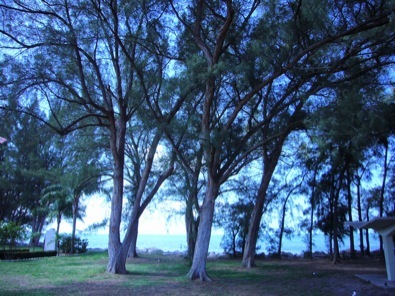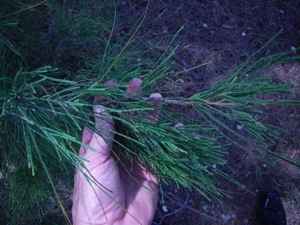Casuarina equisetifolia: Dreaded Edible
It is truly fitting that the Australian Pine ends up on a site dedicated to edible plants because where it has been introduced it is a much-loathed tree by government botanists. But, where it is native the Casuarina was a life saver.
When I first moved to Florida, a life-time ago as a young man escaping snow, I slept out many a night under the Australian Pines listening to the sea breeze whistling through its needle-like branches, which brings up my first point: The Australian Pine is not a true pine. It looks like a pine but it is not a “pinus.” Pine needles are actually modified leaves. What looks like “needles” on the Australian Pine are actually branchlets. On those skinny needle-like branchlets are the minute leaves. So the tree is not edible like a pine. In fact, in Australia that “pine” it is called the She-Oak and the Bull-Oak — no, I have no idea why the gender bending. While not an oak either it does have several overlooked positive elements.
The first is its red sap is drinkable, should you ever need potable water. Next the gum of the tree is edible and was collected by the Aboriginals of Australia, where it is native. They also ate the young “cones” the branchlets and roasted winged seeds, though at 30,000 seeds a pound I’m sure that wasn’t easy.
Australian pines were introduced into Mexico before 1852, to the Caribbean at Barbados in 1870, Hawaii before 1895, and was naturalized in the West Indies and Florida by 1920. The rumor that John Ringling (1866-1936) of circus fame introduced the tree to Florida is not possible as stated. The Australian Pines were around some 14 years before he was born and were naturalized in Florida 16 years before he died. That he could have brought the species to Florida is possible though I would not think probable. Perhaps he planted one in Sarasota, his winter home.
As with many problem plants, the US Department of Agriculture had a hand in the tree’s introduction and proliferation. Seeds were readily available from California by 1908 and it was a common shade tree in Palm Beach by 1921 (the tree can grow eight feet a year, eclipsed only by the Moringa which can easily do 10 feet a year.) It can be trained into a hedge but is extremely vulnerable to fire and intolerant of frost. It also makes an excellent bonsai specimen (see photo on bottom.)
By 1940 it was one of the most widely planted trees in Florida, usually for ditch and canal stabilization as well as a wind break. It was the tree of choice to protect causeways to the Space Center, though artistically interrupted by the Melaleuca, also now on the biological hit list. Several memorable freezes since then has reduce that population but they can still be found along the shores of Indian River lagoon with a good stand unbelievably still at Haulover Canal north of the Space Center. Popular as they were, starting in 1952 cities were crafting ordinances against the species. To cities they pose an enormous financial burden, not only ruining water and sewer mains but buckling streets. Worse, they fall over.
In their native habitat Australian Pines — called Casuarinas — send down strong deep roots to the water which make them extremely stable. They like uneven topography so they can tap into pockets of water. The geography in Florida is such that the tree sends its roots outward for water, horizontally, and is thus very unstable and prone to falling over, even in mild breezes let alone the afternoon hurricanes we call thunder storms or the many true hurricanes of late. Their removal, standing or down, is prohibitively expensive. By 1969 the tree was a serious threat to the Everglades, the Keys and south Florida in general. Yet, as late as 1976 the state’s agricultural department was still selling the trees (clearly a left hand, right hand problem.) On the up side Australian Pines have two flowering seasons and are a significant allergen from December to April and in August and September, keeping allergists in patients and money. Remember, there is no profit in curing an ailment, only in treating one.
If the trees were not invasive they would be recognized for their many good qualities. They return a lot of nitrogen to the soil and have a usable but brittle hard wood. It can be used for carving, small tool handles, boomerangs, spears, rough posts, beams, boat building, electric poles, fences, furniture, mine props, oars, pilings, roofing shingles, wagon wheels, yokes, canoe slats and hulls, shingles and high BTUs firewood. Seasoned outdoor cooks in Florida say it is one of the best woods for barbecuing adding a nice flavor to meats. Australian Pines have been called the best firewood in the world, and it can be burned green off the stump (as can ash.) India plants forests of them just for firewood. The Australian Pine is also noted for its firewood leaving a pure white ash that was ideal as a clothes whitener prior to commercial whiteners. The ash was also used in soap making. I also suspect it can be used to moderate acid in lichen to make them edible.
Of the 17 species seven were introduced to the Americas, four of which are still found here and there. The one on the coast is usually Casuarina equisetifolia, which lives to 40 to 50 years old. Inland in south Florida is the Casuarina glauca, the Swamp Oak or Brazilian Oak. Casuarina cristata, or the Black She-Oak, will not be found anywhere where it is salty and Casuarina Cunninghamiana, the River She-Oak, is found the farthest north in the state — Deland is about it, the 29th parallel or so– and always inland. The coastal one grows twice as tall as the inland ones, reaching 100 to 150 feet. Nothing will grow under them. They hate clay and being waterlogged. Rats don’t like them and their roots can trap sea turtle hatchlings. However, drinkable water can be obtained from the limbs or roots of the trees, the latter preferred. The branchlets can be chewed to moderate thirst. Gum collected from the trunk is melted with warm water to form a jelly prior to eating. The young female “cones” and stems are also chewed to relieve thirst. Or, young cones are cooked and eaten, the older seeds roasted. Fruiting in spring and fall locally, the cones stay on the tree all year. Male trees have flower spikes from yellow to brown at the end of branchlets, while female plants bear globular reddish flowers along the trunk and branches. Species are separated by the number of branchlet whorls and sex.
From a report 118 years ago:
Mr. A. T. Magarey, in a paper entitled “Aboriginal Water Quest,” in Proc. Roy. Geog. Soc. S.A. (session 1894-5), quotes Eyre, Vol. 1, 349-351, for an account of these water-bearing roots.
“Speaking of the Desert Oak (Casuarina Decaisneana, F.v.M.), he quotes Mr. W. H. Tietkens (“Ooldea Water,” region S.A.):— Travelling once with a small native boy of about 10 years of age, and towards the close of a dreadful day, the waterbag long since emptied and the boy gasping for water, and myself no better (the boy was riding a very unusually tall camel, we still had 15 miles more to travel), all at once a cry broke from him, and with one bound he was off that camel and running towards an [She]-oak tree, well four chains distant at least. I stopped the camels and went up to him. He was clawing away at the hot sandy soil, and at last — snap. A root one and a half inches thick was broken, a hard pull, and about 8 feet of root was exposed, lifting the soil as it was raised. About 2 feet length was broken off and upended into the mouth, and a cold drink the result. But not sufficient; another and another length was broken off till we had sufficient. We did not take any more than one root, and I think there were eight or ten more such roots — enough in abundance for a dozen men…..The water so obtained was cool, quite cool, colour- less, and refreshing; but I have noticed that upon exposure to the air for a few hours it becomes a pale brown colour, such as would be noticed in water into which a piece of bark has been dropped.”
Not only do the roots have water, but the branches as well. In Australia where they are often called Casuarinas, many times they grow where there is underground fresh water, even when near the ocean. The Aboriginals knew the tree always meant water one way or another. The tree also played a role in the mysticism of many of indigenous people.
The Tahitians believed they arose from warriors who died in battle, killed by clubs or spears made from the Australian Pine. The warriors’ hair became the foliage and their blood oozed forth once more as the red sap.
Casuarina (Kass-yew-uh-RYE-nuh ) refers to the fine filamentous branches. They supposedly resemble the cassowary feathers . Equisetifolia (ek-wih-set-ih-FOL-ee-uh) means resembling a horse’s tail. Also, most of the Casuarina discussed here have been moved into a different genus, Allocasurina (meaning like the Casuarina.) So you can find them listed both ways.
Green Deane’s “Itemized” Plant Profile
IDENTIFICATION:
Pine-like tree of open, erect growth to 150 feet, dark-green hair-like “needles” are miniature, jointed branches, fruit a cone-like, woody, with sharp points (some species smooth) three quarters of an inch long, half inch wide. Here’s how to tell the local species: Six to eight leaf scales per whorl. C. equisetifolia; C. glauca 10-17 leaf scales per whorl. C. cunninghamiana 8-10 leaf scales per whorl.
TIME OF YEAR:
Sap all year, young branchlets all year, cones when young, summer, they persist all year
ENVIRONMENT:
Varies with species, some tolerate salt well, and are found on shore, others cannot tolerate salt and are usually found inland. They like it wet.
METHOD OF PREPARATION:
From Aboriginal reports: Sap from branches and roots drinkable. Gum from tree or cones edible or can be put in warm water and drank. Young branches and cones chewed to quench thirst. Young cones and leaves edible cooked. Seeds edible when roasted.
HERB BLURB
A decoction from the astringent bark has been used as a remedy for diarrhea, beri-beri, sore throat, cough, headache, toothache, sores, and swellings. They would mix the bark with water for application. Extracts from the bark are also used for tanning hides and staining and preserving fishing lines and fabrics.



